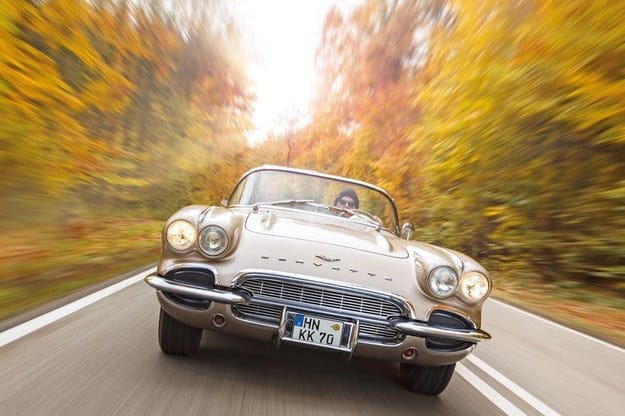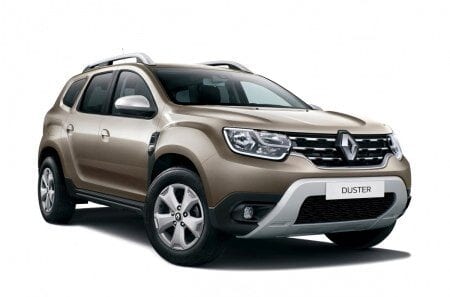
Test drive Chevrolet Corvette C1: Golden Arrow

The first generation of the American sports dynasty in its most mature version
A few years ago, the only legendary American sports car celebrated its 60th anniversary. The 1 Gold Corvette C1962 shares the secrets of its great success.
The first two-seater American sports car, produced in a large series, is designed in the style of a British roadster and at first glance looks like a spectacular failure. More telling than the Corvette's meager sales since production began in 1953, former VIP photographer Edward Quinn's photographs from the late XNUMXs speak for themselves. In them, world movie stars and celebrities boldly pose in proven sports cars such as Alfa Romeo, Austin-Healey, Ferrari, Jaguar, Mercedes-Benz, etc. Not a single Corvette appears anywhere.
Great looks, but too little power
On the other hand, the direct competitor of the Ford Thunderbird, produced since 1955, is very popular. Audrey Hepburn, Liz Taylor, Aristotle Onassis and other VIPs drive a sporty two-seat Ford model with a powerful V8 engine. On the contrary, the early Corvette has modest power - only 150 hp. according to SAE - and a little strange look. Even today, with its large grilled rally headlights and salami-like round fins, it looks like the niche product of a bankrupt smallholder.
A completely different impression comes from our 1962 gold model, with which world-famous movie stars from Cannes and Nice had happy moments. This model, the result of multiple and complete modifications of the original model, is still classified as the first generation C1 and exemplarily combines qualities more or less characteristic of the only true sports car in America: dynamic design with a front-engine layout and strong personality. playful body parts, powerful V8 engines, a wide range of equipment and a guaranteed spectacular parade in front of hotels, street cafes and even the evening before the opera.
For the latter, we can thank the Fawn Beige Metallic champagne that covers the entire body of our C1 Convertible – a color that pairs perfectly with the rich chrome trim as well as the dynamically shaped hardtop. Its slender, forward-slanting window frames, along with slanted vents on the sides, give the convertible a dashing arrow-like feel. The muscular curves of the hips above the rear wheels and the hungry look of the twin headlights underscore the impression of an athlete to be taken seriously despite the automatic transmission, radio, power windows and white-rimmed tires.
Likewise, the cockpit, which the driver can easily enter thanks to the wide doors, does not spare sporting attributes and is somewhat reminiscent of even the race cars of that era. For example, the comfortable single seats of the original model (1953) are separated from each other by a bridge that is part of the body. A central rev counter and a short gear lever in the middle of the floor are also typical sports accessories. To a lesser extent, this applies to the boring two-stage automatic transmission. We will soon learn that this is still enough.
In the meantime, we admire the typical American dashboard, created as a miniature architectural masterpiece. Four additional indicators and a tachometer placed between them crown the dominant semicircle of the speedometer. In right-hand drive vehicles, the entire module, which, like the body, is made of plastic, can be grafted into a recess in front of the right-hand seat.
For a handful of dollars
The eight-cylinder V-twin 5,4-liter engine develops 300 hp. according to SAE, exactly double that of the C1953 with a six-cylinder engine, which appeared in 1 year. The 1962 Corvette was mass-produced with a capacity of 250 hp. Fifty horsepower more costs just $ 53,80, which is six less than power windows. With the aim of Chevrolet equipped the V8 engine with a larger carburetor and increased the rated speed from 4400 to 5000 rpm. Through two invisible V8 tailpipes mounted on the side under the rear, the unit emits an almost smug growl.
We move the automatic transmission lever forward through the R and N positions to leave it in the D position, then release the brake - and find that the car is already moving. With surprisingly low pressure on the accelerator pedal, the high-torque 5,4-liter V8 starts powerfully thanks to an automatic transmission with a torque converter. However, to get into traffic from the dealership parking lot, you need a 180-degree turn that almost ends in a ditch - the Corvette accelerates so easily with its smooth-running V8 engine, its steering wheel spins so hard. You almost can't move it in place - and as you pull and pull, you seriously fear the strength of a beautiful wreath with perforated needles that are thin and sharp almost like a knife.
Almost everything happens in second gear.
Because of these features, it is imperative to follow the typical driving style of the era, with the driver seated at the wheel with arms folded at the elbows. Luckily, even with a hardtop with side windows raised, the Corvette has plenty of room for arms, thighs, and feet on the accelerator pedal. If desired, you can also press on the flip flops, setting the pace of movement. In addition, the panoramic windshield not only provides excellent visibility to the road and bonnet, but also curves forward to free up space.
Driving is a sign of confident calmness, and under normal conditions everything recoups between 1500 and 2500 rpm - almost only in second (fast) gear, which the automatic engages even at a low pace. The fairly precise steering and firm brakes are quickly accustomed to, so after only a few kilometers we are sailing energetically and without the stress of everyday traffic. If it wasn't for that light, airy, uniquely shaped cabin with cool champagne surfaces, brushed silver and shiny chrome details, we might forget we've been traveling in a sports car for over 50 years.
After the first test trip, we return to the starting point, release the hardtop with a few movements and place it in the corner of the car dealership service workshop. Now the Corvette is showing off the typical C1-generation “cherry” design – a jumper between the seats that descends into the cabin. Through it, the body, as it were, bends and wraps around the shoulders of two passengers. No production roadster in Europe has this feature. And another big plus: the textile guru is hidden under an elegant cover.
Dominant cravings
Despite all the design and comfort, our Corvette can be carried by the wind with bulging sails. To do this, it is enough to fully press the accelerator pedal - then the tachometer needle immediately jumps to 4000 rpm and remains there. About tenths of a second later, backed up by a bass roar, you're hit by a Saturn rocket that slams the driver into the seat and makes the two rear tires screech.
Above 30 miles per hour, revs grow rapidly, as does speed. The 60 mph (98 km / h) clutch is achieved in second gear in just over eight seconds, with the only gear change occurring at 5000 rpm without interruption. And then the speedometer needle continues to move vigorously in the direction of one hundred miles (about 160 km / h).
We would have gone a lot faster if we had an injected V8 delivering 360 hp. according to SAE and in combination with a four-speed manual transmission. With it, our gold C1 from 62 sprints to 100 km / h in just six seconds, and its top speed will be 240 km / h. Neither the Mercedes 300 SL Roadster, nor the Jaguar E-Type, nor many Ferrari models could match our car.
This dominant attraction to everything and everyone, along with a charming appearance and a solid dose of comfort (with undeniable suitability for everyday driving), is one of the main characteristics of all generations of Corvette - and many other classic American models. But so far, only one manufacturer has managed to question the packaging of an attractive compact sports car, and that manufacturer is Chevrolet. This has been going on for over 60 years. In the past, the Corvette has overcome the valley of tears by reducing its power to 165 hp. in 1975 again competed with Ferrari and the company, reaching 659 hp. with today's C7 Z06. The popular expression “They will come back someday” is especially relevant here.
CONCLUSION
Editor Franz-Peter Hudek: It's easy to explain that the later V8 Corvette generation C1 is also the preferred classic car in Europe. They're easy to handle, have decent traction, offer relatively large space, and set off a firework of sophisticated design ideas. The fact that the Corvette is still in production today makes the first generation even more valuable.
TECHNICAL DATA
Chevrolet Corvette C1 (1962)
ENGINE V-90 engine (cylinder bank angle 101,6 degrees), bore x stroke 82,6 x 5354 mm, displacement 300 cc, 5000 hp. according to SAE at 474 rpm, max. torque 2800 Nm at 10,5 rpm, compression ratio 1: XNUMX, hydraulic valve tappets, centrally located camshaft driven by a timing chain, four-chamber carburetor (Carter).
POWER GEAR Rear-wheel drive, three-speed manual transmission, optional four-speed manual or two-speed automatic transmission, optional rear axle limited-slip differential.
BODY AND UNDERGROUND A two-seater convertible with a fully submersible textile guru, optionally a removable hard top, a plastic body with a steel support frame made of closed profiles and X-shaped crossbars. Independent front suspension with double triangular crossbars and coaxially connected springs and shock absorbers, rear rigid axle with leaf springs, front and rear stabilizers. Telescopic shock absorbers, four drum brakes, optionally with sintered pads.
DIMENSIONS AND WEIGHT Length x width x height 4490 x 1790 x 1320 mm, wheelbase 2590 mm, front / rear track 1450/1500 mm, weight 1330 kg, tank 61 liters.
DYNAMIC PERFORMANCE AND CONSUMPTION Top speed 190–200 km/h, acceleration from 0 to 100 km/h in 7–8 seconds (depending on transmission), consumption 15–19 l/100 km.
DATE OF PRODUCTION AND CIRCULATION Corvette C1, 1953 - 1962, last version (with C2 back) only 1961 and 1962, 25 copies were produced from it.
Text: Frank-Peter Hudek
Photos: York Kunstle
